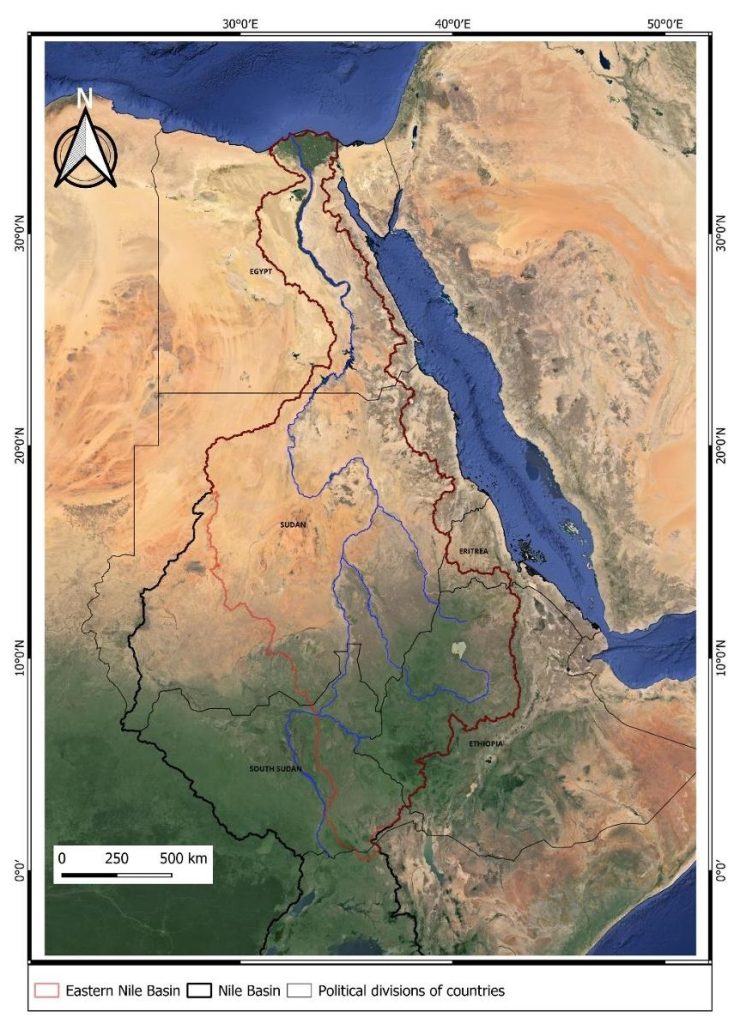The Eastern Nile Basin is a transboundary basin predominantly covering areas in Ethiopia, South Sudan, Sudan, and Egypt, with a minor section of the Tekeze River (Atbara) extending into Eritrea near the Ethiopian-Sudanese border (Arsano & Tamrat, 2005). It drains a total area of 1,809,606 km² (Abdelwares et al., 2019). Its distribution among the four countries is as follow South Sudan occupies the largest portion (61%), followed by Ethiopia (22%), Sudan (13%), and Egypt (4%) (Abdelwares et al., 2019). The Nile River is the longest river globally, with an approximate length of 6,700 km (Allan et al., 2019). The Nile River Basin extends over eleven African countries and has a drainage area of about 3.15 million km² (McNamara et al., 2021).

Figure 1 : Eastern Nile Basin boundaries.
There is a wide range in water availability in the Eastern Nile Basin, from plenty to scarcity. While Egypt, Sudan, and South Sudan face water scarcity and competition for freshwater resources, Ethiopia enjoys an abundance of water resources (Mohamed & Loulseged, 2008). Precipitation varies greatly in the ENB, which affects land use and water availability. The decrease in precipitation can worsen water scarcity, impacting ecosystems and agriculture that depend on the Nile. According to scientific data, climate change is probably going to make droughts more frequent and severe in the area, which will put further strain on the region’s water supplies (Lazin et al., 2023).
Due to this lack of water, conflicts in the Eastern Nile Basin are more severe than those in the Nile Basin (Ghoreishi et al., 2023). Ethiopia is ranked 157/169 in 2010 on the global poverty scale, meaning that it has chronic food insecurity and is one of the countries with the highest requirements for food aid. Egypt, on the other hand, is ranked fourth among the world’s most water-scarce countries and fifth at the highest risk of water stress, both of which are expected to be exacerbated by the effects of climate change (Østigård, 2012).
References
- Abdelwares, M., Lelieveld, J., Hadjinicolaou, P., Zittis, G., Wagdy, A., & Haggag, M. (2019). Evaluation of A Regional Climate Model for the Eastern Nile Basin: Terrestrial and Atmospheric Water Balance. Atmosphere, 10(12), 736. https://doi.org/10.3390/atmos10120736
- Allan, J. R., Levin, N., Jones, K. R., Abdullah, S., Hongoh, J., Hermoso, V., & Kark, S. (2019). Navigating the complexities of coordinated conservation along the river Nile. Science Advances, 5(4), eaau7668. https://doi.org/10.1126/sciadv.aau7668
- Arsano, Y., & Tamrat, I. (2005). Ethiopia and the Eastern Nile Basin. Aquatic Sciences, 67(1), 15–27. https://doi.org/10.1007/s00027-004-0766-x
- Ghoreishi, M., Elshorbagy, A., Razavi, S., Blöschl, G., Sivapalan, M., & Abdelkader, A. (2023). Cooperation in a transboundary river basin: A large-scale socio-hydrological model of the Eastern Nile. Hydrology and Earth System Sciences, 27(5), 1201–1219. https://doi.org/10.5194/hess-27-1201-2023
- Lazin, R., Shen, X., Moges, S., & Anagnostou, E. (2023). The role of Renaissance dam in reducing hydrological extremes in the Upper Blue Nile Basin: Current and future climate scenarios. Journal of Hydrology, 616, 128753. https://doi.org/10.1016/j.jhydrol.2022.128753
- McNamara, I., Baez-Villanueva, O. M., Zomorodian, A., Ayyad, S., Zambrano-Bigiarini, M., Zaroug, M., Mersha, A., Nauditt, A., Mbuliro, M., Wamala, S., & Ribbe, L. (2021). How well do gridded precipitation and actual evapotranspiration products represent the key water balance components in the Nile Basin? Journal of Hydrology: Regional Studies, 37, 100884. https://doi.org/10.1016/j.ejrh.2021.100884
- Mohamed, Y., & Loulseged, M. (2008). The Nile Basin Water Resources: Overview of Key Research Questions Pertinent to the Nile Basin Initiative. Colombo, Sri Lanka: International Water Management Institute, 34p.
- Østigård, T. (2012). Water scarcity and food security along the Nile: Politics, population increase and climate change. Nordiska Afrikainstitutet.